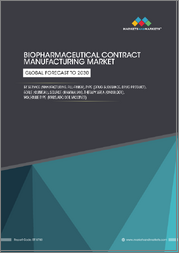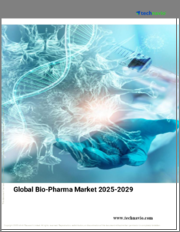
|
시장보고서
상품코드
1430597
일본의 의약품 3PL : 시장 점유율 분석, 산업 동향 및 통계, 성장 예측(2024-2029년)Japan Pharmaceutical 3PL - Market Share Analysis, Industry Trends & Statistics, Growth Forecasts (2024 - 2029) |
||||||
일본의 의약품 3PL(제3자물류) 시장 규모는 2024년 674억 1,000만 달러로 추계되고, 2029년 943억 7,000만 달러에 이를 것으로 예측되며, 예측 기간 중(2024-2029년) CAGR은 7%로 성장할 전망입니다.
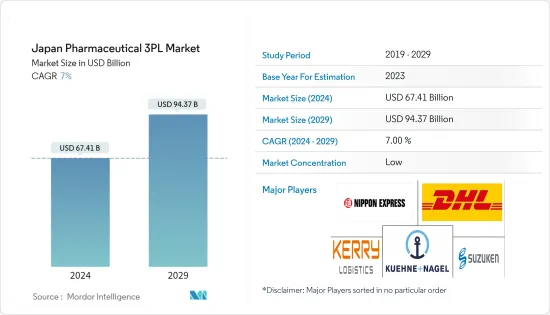
주요 하이라이트
- 의약품 업계의 제3자 물류 시장이 확대되고 있는 이유는 온라인 배송 서비스를 이용하는 사람이 늘고 있기 때문입니다. 이 동향에 의해 3PL 솔루션 수요가 높아지고 있습니다. 일본은 의약품 3PL 시장을 견인하고 있으며 정부가 인센티브를 제공합니다. 일본의 의약품 의료기기 종합기구는 일본의 후생노동성 및 제약회사와 공동으로 온라인 정보교환 및 환자상담 서비스를 위한 플랫폼을 구축했습니다.
- 국제적인 국경을 넘어 생물제제를 수송하기 위한 온도관리된 물류 서비스에 대한 수요와 매출을 늘리기 위한 바이오의약품 기업의 유통망 확대가 시장 확대를 추진하는 동기가 되고 있습니다. 의약품 물류 기업은 신흥 국가에서 자동 보관 및 검색 시스템의 사용이 크게 증가하고 있음을 알고 있습니다. 공급 중단을 제한하고 중요한 치료를 선호함으로써 시장의 주요 기업은 COVID-19와의 전투에서 중요한 역할을 수행했습니다.
- 예를 들어, 일본통운은 사이타마현 구키시에 있는 동일본 의약품 센터에서 WHO 표준 GDP 인증을 취득하고 있습니다. 이는 고품질 물류 수요에 부응하기 때문에 두 온도대에서의 보관 및 운송에 집중하고 있기 때문입니다. 이 센터는 2개의 온도대(상온: 15-25℃, 냉장: 2-8℃)에서 의약품을 보관 및 운송하는 WHO(세계 보건기구)의 표준 GDP 인증을 취득하고 있습니다.
일본의 의약품 3PL 시장 동향
국내에서 성장하는 제네릭 의약품 시장
일본의 제네릭 의약품 시장은 최근 몇 년동안 점점 더 많은 제약 회사가 일어나고 급속한 피치로 성장하고 있습니다. 평균 수명이 늘어나고 노화됨에 따라 기존 공급업체가 새로운 솔루션을 찾아야 하기 때문에 일본 제네릭 의약품은 현재 의약 업계에서 가장 빠르게 성장하는 부문 중 하나가 되었습니다. 일본은 높은 기술력과 시장 경쟁의 치열함으로 알려진 나라입니다. 또한 국민 1인당 헬스케어 지출도 세계 최고 수준에 있습니다.
미국이나 EU 등 다른 신흥국 시장에 비해 일본에서는 제네릭 의약품의 보급률은 항상 낮았습니다. 그러나 금세기에 들어서는 정부의 정책 전환으로 제네릭 의약품 복용자 수가 급속히 증가하고 있습니다.
고령화가 진행됨에 따라 선발 의약품 가격이 급등함에 따라 정부는 의료비를 절감하고 저비용 제네릭 의약품에서 혁신적인 제품으로 자금을 옮기는 법을 성립했습니다. 정부는 2020년 9월까지 제네릭 의약품 보급률 80%를 목표로 내걸었으나 그 달성률은 약 2%에 그쳤습니다. 2021년 9월 현재 일본의 의료용 의약품 시장에서 제네릭 의약품의 점유율은 약 79%였습니다.
제네릭 의약품은 저렴한 선발 의약품을 요구하는 기업과 개인에게 좋은 시장이었습니다. 고가의 브랜드 의약품의 제네릭 의약품을 만들 때, 제약 회사는 맛, 외형, 향기, 사용감까지 고가의 브랜드 의약품과 동일하게 하려고 했습니다. 이 모방 버전은 선도적인 제조 업체의 가장 인기있는 약품 이름을 따서 명명되었기 때문에 고객은 제네릭과 선발 제품의 차이를 거의 볼 수 없었습니다.
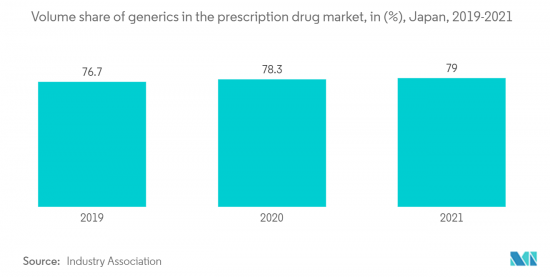
수입 의약품 증가
일본은 미국의 의약품 수출 시장이며, 세계 제3위의 의약품 시장입니다. 헬스케어 분야는 일본 정부의 경제 재생 및 성장 전략 하에서의 성장 촉진요인으로서, 2013년 이후, 일본 정부(이하 「GOJ」)에 의해 판매되고 있습니다. 일본의 의약품 업계는 헬스케어 업계와 함께 최근 새로운 관심을 모으고 있습니다. 일본의 헬스케어 산업에 대한 관심 증가는 혁신적인 헬스케어 상품의 가치를 돋보이게 한 COVID-19 팬데믹에도 기인하고 있습니다. 일본의 창약 환경의 강화가 요구되고 있는 것도, 일본의 의약품 산업에 대한 관심을 높이는 큰 요인이 되고 있습니다. 일본으로의 의약품 수입의 약 20%는 미국 제품이 차지하고 있으며, 여기에는 미국 기업이 현지에서 생산한 것과 일본 제조업자에게 라이선스를 부여한 것이 포함됩니다.
2025년까지 일본의 의약품 시장은 연률 0.2-1.2%의 페이스로 축소될 것으로 예상되는 한편, 세계의 의약품 시장은 4.4%의 페이스로 확대될 것으로 예상됩니다. 일본의 비특허 의약품 시장의 축소는 일본의 의약품 부문이 축소하는 요인 중 하나입니다. 그러나 미국 기업이 자랑하는 일본 특허 의약품 시장은 앞으로도 확대가 계속될 것으로 예상됩니다.
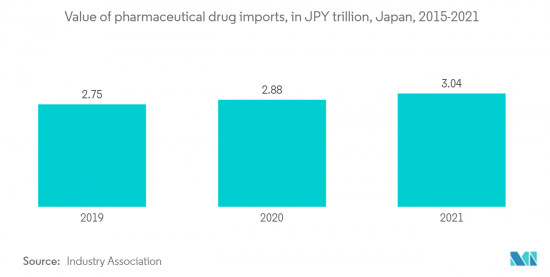
일본 의약품 3PL 업계 개요
일본의 의약품 3PL 시장은 매우 경쟁이 심합니다. 운송되는 품목의 섬세함을 고려하여, 의약품 물류에는 고급 전문성, 규제 당국의 승인, 최첨단 기술, 보다 광범위한 네트워크 및 많은 전문 지식이 요구됩니다. DHL Logistics, Nippon Express, Kuehne Nagel, Kerry Logistics 등이 시장의 선두 기업입니다. 이러한 기업들은 보다 신속한 배송과 전문적인 보관 시설을 통한 창고 보관 옵션을 제공함으로써 경쟁력을 높이고 있습니다.
기타 혜택 :
- 엑셀 형식 시장 예측(ME) 시트
- 3개월간의 애널리스트 서포트
목차
제1장 서론
- 조사의 전제 조건 및 시장 정의
- 시장 범위
제2장 조사 방법
제3장 주요 요약
제4장 시장 인사이트
- 시장 개요
- 현재의 시장 시나리오
- 정부의 대처와 규제
- 기술 동향
- 업계 공급망 및 밸류체인 분석
- 투자 시나리오
- 일본의 의약품 전자상거래 시장
- 의약품 포장의 주목점(세계의 동향 및 지역의 동향)
- 시장에 대한 COVID-19의 영향(시장 및 경제에 대한 단기적 및 장기적 영향 포함)
제5장 시장 역학
- 성장 촉진요인
- 억제요인
- 기회
- 업계의 매력-Porter's Five Forces 분석
- 공급기업의 협상력
- 소비자의 협상력
- 신규 참가업체의 위협
- 대체품의 위협
- 경쟁 기업간 경쟁 관계
제6장 시장 세분화
- 서비스별
- 국내 운송 관리
- 국제 운송 관리
- 부가가치형 창고 및 배송
- 온도 관리별
- 온도관리 및 콜드체인 물류
- 비관리 및 비콜드체인 물류
제7장 경쟁 구도
- 시장 집중도 개요
- 합병 및 인수
- 기업 프로파일
- Suzuken Group
- Nippon Express
- DHL Logistics
- Kuehne Nagel
- Kerry Logistics
- Mitsubishi Logistics
- Ceva Logistics
- DB Schenker
- FedEx
- Yusen Logistics*
제8장 시장 기회 및 앞으로의 동향
제9장 부록
- 거시경제지표(GDP분포, 활동별)
- 경제 통계-운송 및 창고업의 경제에의 공헌
- 대외무역통계-제품별, 목적지 및 원산국별 수출입액
The Japan Pharmaceutical 3PL Market size is estimated at USD 67.41 billion in 2024, and is expected to reach USD 94.37 billion by 2029, growing at a CAGR of 7% during the forecast period (2024-2029).

Key Highlights
- The pharmaceutical industry's third-party logistics market is growing because more and more people are willing to use online delivery services. This trend has led to a rise in demand for third-party logistics solutions. Japan has been the leading force in the pharmaceutical third-party logistics market, with the government providing incentives. The Japanese Pharmaceutical and Medical Devices Agency, in partnership with the Japanese Ministry of Health, Labour, and Welfare and drug companies, created a platform for online information exchange and patient consultation services.
- The demand for temperature-controlled logistics services to ship biologics across international borders and the expansion of biopharmaceutical companies' distribution networks to boost sales are fueling market expansion. It serves as motivation. Pharmaceutical logistics organizations have noticed a considerable increase in the use of automated storage and retrieval systems in emerging nations. By limiting supply disruptions and giving priority to crucial treatments, major market actors played a significant role in the fight against COVID-19.
- For example, Nippon Express has WHO Standard GDP Certification for the East Japan Pharmaceutical Center in Kuki, Saitama Prefecture. This is because they focus on storage and transit with two temperature zones to meet the demand for high-quality logistics. The center has WHO (World Health Organization) standard GDP certification for storing and transporting medications in two temperature zones (room temperature: 15-25°C, cold storage: 2-8°C).
Japan Pharmaceutical 3PL Market Trends
Generics drugs market growing in the country
The generic drug market in Japan is growing at a rapid pace, with more and more drug companies starting up in the past few years. Japanese generics are now one of the fastest-growing segments in the pharmaceutical industry, as rising life expectancy and an aging population put pressure on existing suppliers to find new solutions. Japan is a country known for its high technology and strong market competition. It also has one of the highest healthcare expenditures per capita in the world.
Comparing Japan to other developed markets like the US and EU, generic medicine penetration has always been lower in Japan. Since the turn of the century, however, the number of people taking generic drugs has grown quickly due to a change in government policy.
In response to the country's aging population and the rising cost of branded drugs, the government passed a law to cut medical spending and move money from low-cost generics to innovative products. By September 2020, the government set a goal of 80% generic medicine penetration, although it only achieved roughly 2% of that aim. In the Japanese prescription medicine market as of September 2021, generics held a share of roughly 79%.
Generics were a good market for businesses and individuals who wanted brand-name drugs at cheap prices. When making generic versions of more expensive brands, pharmaceutical companies tried to make them taste, look, smell, and even feel like the more expensive brands. These copycat versions were named after the most popular drug names from major manufacturers, so customers could hardly tell the difference between a generic and its branded counterpart.

Pharmaceutical imports growing in the country
Japan is an export market for American pharmaceuticals and the third-largest pharmaceutical market in the world. The healthcare sector was marketed by the Government of Japan ("GOJ") since 2013 as a growth driver under the nation's economic revival and growth strategy. The pharmaceutical industry in Japan, along with the healthcare industry, has recently attracted new interest. This increased interest in Japan's healthcare industry is partly due to the COVID-19 pandemic, which highlighted the value of innovative healthcare goods. The requirement to strengthen Japan's drug discovery environment is a significant additional factor driving interest in the country's pharmaceutical industry. About 20% of all pharmaceutical imports into Japan are made up of American products, including those produced locally by American businesses and those that have been licensed to Japanese producers.
Through 2025, the pharmaceuticals market in Japan is expected to contract at a rate of 0.2-1.2% per year, while the global pharmaceuticals market is anticipated to expand at a rate of 4.4%. A concomitant fall in Japan's off-patent drug market is one of the factors contributing to the expected decline in the country's pharmaceutical sector. However, it is anticipated that the Japanese market for patented drugs, where U.S. corporations' goods shine, will continue to expand throughout this time.

Japan Pharmaceutical 3PL Industry Overview
The pharmaceutical third-party logistics (3PL) market in Japan is very competitive. Given the sensitivity of the items being transported, pharmaceutical logistics demands a high degree of specialization, regulatory approvals, cutting-edge technology, greater network coverage, and a great deal of expertise; hence, the industry has comparably fewer competitors. DHL Logistics, Nippon Express, Kuehne + Nagel, and Kerry Logistics are some of the market's top companies. These firms are gaining a competitive edge by providing options for quicker shipping and warehousing with specialized storage facilities.
Additional Benefits:
- The market estimate (ME) sheet in Excel format
- 3 months of analyst support
TABLE OF CONTENTS
1 INTRODUCTION
- 1.1 Study Assumptions and Market Definition
- 1.2 Scope of the Market
2 RESEARCH METHODOLOGY
3 EXECUTIVE SUMMARY
4 MARKET INSIGHTS
- 4.1 Market Overview
- 4.2 Current Market Scenario
- 4.3 Government Initiatives and Regulations
- 4.4 Technological Trends
- 4.5 Industry Supply Chain/Value Chain Analysis
- 4.6 Investment Scenarios
- 4.7 Pharmaceutical E-Commerce Market in Japan
- 4.8 Spotlight on packaging of pharmaceuticals (global and regional trends)
- 4.9 Impact of COVID-19 on market (including short-term and long-term effects on the market as well as the economy)
5 MARKET DYNAMICS
- 5.1 Drivers
- 5.2 Restraints
- 5.3 Opportunities
- 5.4 Industry Attractiveness - Porter's Five Forces Analysis
- 5.4.1 Bargaining Power of Suppliers
- 5.4.2 Bargaining Power of Consumers
- 5.4.3 Threat of New Entrants
- 5.4.4 Threat of Substitutes
- 5.4.5 Intensity of Competitive Rivalry
6 MARKET SEGMENTATION
- 6.1 By Service
- 6.1.1 Domestic Transportation Management
- 6.1.2 International Transportation Management
- 6.1.3 Value-added Warehousing and Distribution
- 6.2 By Temperature Control
- 6.2.1 Controlled/Cold Chain Logistics
- 6.2.2 Non-controlled/Non-Cold Chain Logistics
7 COMPETITIVE LANDSCAPE
- 7.1 Market Concentration Overview
- 7.2 Mergers & Acquisitions
- 7.3 Company Profiles
- 7.3.1 Suzuken Group
- 7.3.2 Nippon Express
- 7.3.3 DHL Logistics
- 7.3.4 Kuehne + Nagel
- 7.3.5 Kerry Logistics
- 7.3.6 Mitsubishi Logistics
- 7.3.7 Ceva Logistics
- 7.3.8 DB Schenker
- 7.3.9 FedEx
- 7.3.10 Yusen Logistics*
8 MARKET OPPORTUNITIES AND FUTURE TRENDS
9 APPENDIX
- 9.1 Macroeconomic Indicators (GDP Distribution, by Activity)
- 9.2 Economic Statistics - Transport and Storage Sector Contribution to the Economy
- 9.3 External Trade Statistics - Exports and Imports by Product and by Country of Destination/Origin




